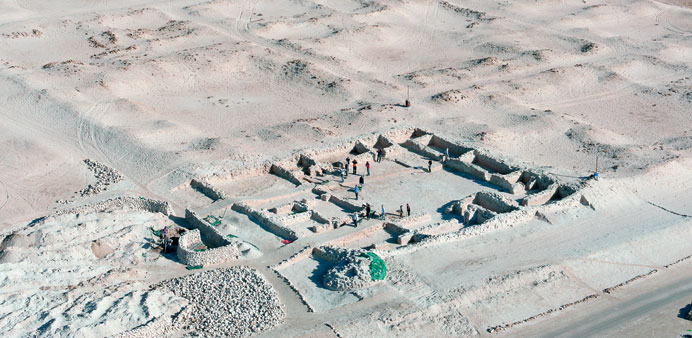By Bonnie James/Deputy News Editor
Qatar’s Al Zubarah Archaeological Site, which has outstanding universal value as the Gulf’s most complete and well-preserved pearl trading and diving town of the 18th-19th centuries, is likely to be inscribed in the Unesco World Heritage List.
“The nomination process will be completed this month,” Qatar Museums Authority’s chief archaeology officer Prof Thomas Leisten said yesterday.
Qatar’s largest and most impressive archaeological site, the abandoned coastal town of Al Zubarah, with 60 hectares of ruins within its former walls, is situated about 100km to the northwest of Doha in the district of Al Shamal.
The settlement was founded around 1760 by the Banu Utba tribe from Kuwait, seeking to create a safe trading haven in the Gulf, as other long-established ports were destroyed, occupied, or ridden with plague.
Over a very short period of time, Al Zubarah, quickly rose to become the foremost centre for pearl-based trade and commerce in the region, and Qatar’s largest and most important town.
Its location in central Gulf was instrumental in making Al Zubarah the premier pearling and trading town in the region after the decline of Basra in Iraq.
Al Zubarah Archaeological Site represents the only complete urban plan of an Arabian pearl-merchant town, with its unique combination of neighbourhoods, mosques, palaces, markets, defensive systems and a canal.
The town plan of Al Zubarah encapsulates and preserves key ideas about urbanism and town planning during the 18th-19th centuries, and it is the best-preserved record of its type.
In 1811, Al Zubarah was destroyed by Omani forces and never recovered. The town survived until the end of the 19th century as a small pearl fishing community only to be gradually abandoned during the first half of the 20th century.
The Nominated Property includes the entire town, harbour, canal, screening walls, cemeteries, and Qal’at Murair – a square fortified settlement 2.5km to the south of Al Zubarah – the purpose of which was to guard a series of freshwater wells that were essential for the survival Al Zubarah, as the harbour town had no fresh water on its own.
Opposite to Qal’at Murair, destroyed in the latter part of the 20th century and survives today largely as sub-surface archaeology, is Al Zubarah fort, the best preserved feature, built in 1938 by Sheikh Abdullah bin Jasim al-Thani as part of a complex defense system to protect Qatar’s northern coastline.
Al Zubarah was first reported as an archaeological site by a Danish-led team in the 1950s and excavated in 1980 by Qatar’s National Council of Culture, Arts and Heritage and between 2002 and 2005 by the QMA.
Since 2009, a joint project between the University of Copenhagen and QMA, called Qatar Islamic Archaeology and Heritage Project, has led to large-scale excavations and restorations, as well as to historical, anthropological and environmental research efforts in Al Zubarah and its hinterland.

Excavation of southeastern courtyard of the palatial compound at Al Zubarah.


